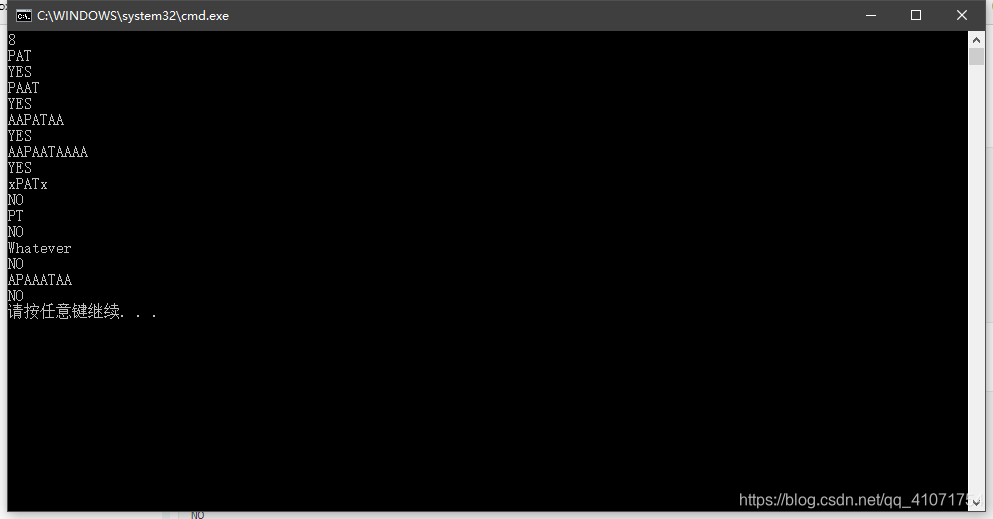【PAT乙级】1003 我要通过!
本文共 2596 字,大约阅读时间需要 8 分钟。
1003 我要通过! (20分)
“答案正确”是自动判题系统给出的最令人欢喜的回复。本题属于 PAT 的“答案正确”大派送 —— 只要读入的字符串满足下列条件,系统就输出“答案正确”,否则输出“答案错误”。得到“答案正确”的条件是:
- 字符串中必须仅有 P、 A、 T这三种字符,不可以包含其它字符;
- 任意形如 xPATx 的字符串都可以获得“答案正确”,其中 x 或者是空字符串,或者是仅由字母 A 组成的字符串;
- 如果 aPbTc 是正确的,那么 aPbATca 也是正确的,其中 a、 b、 c 均或者是空字符串,或者是仅由字母 A 组成的字符串。
现在就请你为 PAT 写一个自动裁判程序,判定哪些字符串是可以获得“答案正确”的。
输入格式:
每个测试输入包含 1 个测试用例。第 1 行给出一个正整数 n (<10),是需要检测的字符串个数。接下来每个字符串占一行,字符串长度不超过 100,且不包含空格。输出格式:
每个字符串的检测结果占一行,如果该字符串可以获得“答案正确”,则输出 YES,否则输出 NO。输入样例:
8PATPAATAAPATAAAAPAATAAAAxPATxPTWhateverAPAAATAA
输出样例:
YESYESYESYESNONONONO

思路分析:
- 这个题关键在于读懂题,能读懂题很重要啊!一开始我就没看懂题,看了其他hxd的思路才算是明白了,下面我们就来分析一下题目的三个条件。
条件1:字符串中必须仅有 P、 A、 T这三种字符,不可以包含其它字符;
- 此处说的很清楚了,输入的字符串只能是带有P、A、T这三种字符的字符串,含有其他字符就算错
条件2:任意形如 xPATx 的字符串都可以获得“答案正确”,其中 x 或者是空字符串,或者是仅由字母 A 组成的字符串;
- 条件2结合条件1,就得出了输入的字符串必须含有P、A、T这三个字符,且形式必须为xPATx型,即PAT两边要么全为空;要么全是A,且两边对称
条件3:如果 aPbTc 是正确的,那么 aPbATca 也是正确的,其中 a、 b、 c 均或者是空字符串,或者是仅由字母 A组成的字符串。
- 满足条件3的前提是满足条件1和2,千万不要把它当成一个单独的正确形式!!! 而要把它理解成为一个附加条件,即xPATx型正确,那么xPAATxx也是正确的,例如:APATA [√],那么APAATAA也[√]
- 条件分析完了,那么解题的重点是什么呢?我认为解题的重点在于确定P前,P与T之间,T之后A的个数,我们对3个条件进行简单的分析就可以看出:P前A的个数 × P与T之间A的个数 = T之后A的个数 ;这是由于条件限制所得出的规律,a与c要对称,且b只能等于A,所以P与T之间A的个数要么是1要么是2,当P与T之间A的个数为1时,a = b,当P与T之间A的个数为2时,a = 2b
- 算法漏洞:通过对条件的分析,我们得出了简单算法 P前A的个数 × P与T之间A的个数 = T之后A的个数 ,但是这个算法有一个漏洞在于:APT为显示yes,这是因为1 × 0 = 0,符合算法条件,这是目前市面上大多数解题思路都没有想到的(也可能是懒得想,毕竟一个小题不值得浪费太多时间,不考虑这个也可以通过测试),为了保证解题的严谨性,我们可以再在代码上加上一个限制条件:P与T之间A的个数 != 0,来避免这种情况。
代码实现:
// 此处给出两种写法// 这里的两种写法虽然写法不同,但是思想是一致的// 写法一#includeusing namespace std;void solve() { int x; scanf("%d", &x); getchar(); for (int i = 0; i < x; i++) { int Aqnum = 0, Aznum = 0, Ahnum = 0; int P, A, T; P = A = T = 0; // P A T 的个数 int rp = 1; // 控制 是 P 前 还是 P~T之间 和 T 之后的变量 【1 2 3 前中后】 int cnd = 1; // 若含有其他字符就改为 0 for (char s; s=getchar(), s != '\n';) { s == 'P' ? P++, rp = 2 : s == 'A' ? A++ : s == 'T' ? T++, rp = 3 : cnd = 0; // 可以使用if来写 其实也就是这个意思。 switch (rp) { case 1:Aqnum++; break; // 前 case 2:if (s != 'P') Aznum++; break; // 中 case 3:if (s != 'T') Ahnum++; break; // 后 } } if (P == 1 && A &&T == 1 && Aznum != 0 && Aqnum*Aznum == Ahnum && cnd) // 只有1个P 只有1个T 并且满足乘法 还满足 没有其他字符的话 printf("YES\n"); else printf("NO\n"); }}int main() { solve(); return 0;}// 写法二#include #include #include using namespace std;int main(){ int t; scanf("%d",&t); char s[107]; while(t--) { int Pflag=0,Tflag=0; //P所在位置的下标,T所在位置的下标 int anum=0,pnum=0,tnum=0; //A的数量,P的数量,T的数量 int aanum=0,banum=0,canum=0; //P左边的A的数量,P和T中间A的数量,T右边的A的数量 scanf("%s",s); for(int i=0;i
运行结果图:


转载地址:http://nqoi.baihongyu.com/
你可能感兴趣的文章
NLP 项目:维基百科文章爬虫和分类【01】 - 语料库阅读器
查看>>
NLP_什么是统计语言模型_条件概率的链式法则_n元统计语言模型_马尔科夫链_数据稀疏(出现了词库中没有的词)_统计语言模型的平滑策略---人工智能工作笔记0035
查看>>
NLP、CV 很难入门?IBM 数据科学家带你梳理
查看>>
NLP三大特征抽取器:CNN、RNN与Transformer全面解析
查看>>
NLP入门(六)pyltp的介绍与使用
查看>>
NLP学习笔记:使用 Python 进行NLTK
查看>>
NLP度量指标BELU真的完美么?
查看>>
NLP的不同研究领域和最新发展的概述
查看>>
NLP的神经网络训练的新模式
查看>>
NLP采用Bert进行简单文本情感分类
查看>>
NLP问答系统:使用 Deepset SQUAD 和 SQuAD v2 度量评估
查看>>
NLP项目:维基百科文章爬虫和分类【02】 - 语料库转换管道
查看>>
NLP:从头开始的文本矢量化方法
查看>>
NLP:使用 SciKit Learn 的文本矢量化方法
查看>>
NLTK - 停用词下载
查看>>
nmap 使用总结
查看>>
nmap 使用方法详细介绍
查看>>
nmap使用
查看>>
nmap使用实战(附nmap安装包)
查看>>
Nmap哪些想不到的姿势
查看>>